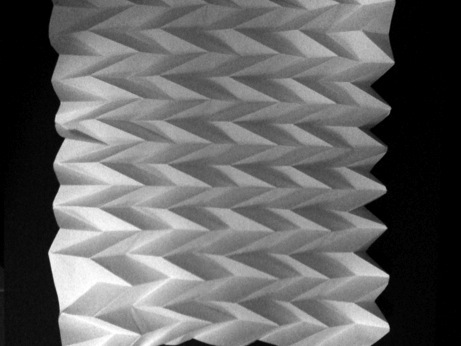
Architectura & Natura I was my first commission at the Academy for Architecture and Urbanism Tilburg.
Instructors: Claudia Schmidt, Jurgen Stoye, Stijn Kriele, Mark van Veen.
Assignment: Each student chooses a type of grass as the starting point for this three step design project.
1. Analyze the (growth) structure of the grass and convert it into a structural model.2. Transform the structural model in to a construction.
3. This step will be explained later on...
Process:
Peculiar to grass is its admirable proportion. Although its small width it can reach incredible heights.
I found a clear structure by studying the cell wall at a microscopic level. I abstracted this structure and visualized it with a tensegrity model.
Initially the model was equipped with elastic tension strings. High flexibility was achieved, however the model couldn’t bear any pressure.
A model with rigid tension members was the logical consequence.




I experimented with facades and introduced a scale figure. It showed that the system was inhibited by its length-width ratio. Creating a functional area was nearly impossible.

I increased the number of rods per layer. A growth of interior space resulted. Yet the density at the facade grew rapidly along. I considered this undesirable - a new solution had to be found.

Inverting the tension and compression members resulted into an interior space of a larger-scale without affecting the density of the facade. Unfortunately the attractive twist in the shell was sacrificed.

I was able to maintain the quality of the facade - with its diagonal play of lines, - and the internal space by a new experiment: Paper. The outcome: a plane with a spectacular structure.


The structure forced me to flip it 90 degrees in order to create a closed element - a whole new sculptural form was born.

The internal space paradoxically lost its size. Progressive learning however brought me a new perception. The loss of space isn’t necessarily negative. In this case it enhances the perception of form and space.
The limited space inside the structure compels inventive thinking. Why create an internal vertical ascension when there is a brilliant extern routing available?
The limited space inside the structure compels inventive thinking. Why create an internal vertical ascension when there is a brilliant extern routing available?

The new born sculpture seems to be a totally farfetched when looking at the initial model. First the tensile and compression members determined the architecture, now the faces fulfill this role. Although the structure appears to be more complex it is still honest conform its initial principles: The sculpture is composed out of triangles whose vectors are equal to the vectors of the tensegrity model.
Reflection:
The most important thing I learned and experienced during the first phase of this three step project is the essential difference between form-making and form-finding. My process was initially inhibited because I took programmatic usability in account. The weekly creation of models broke this mind set.
A form of trial-and-error brought me a new insight free from constraints and led me into discovering shapes and spaces instead of conceiving them.
When reviewing the process the transition from an open to a closed structure appears to be remarkable. Reckoning the initial tensegrity model never reached its full potential. The cause should be found in my fascination for the experiment. Wether this chain of events is positive or negative remains to be seen. Nevertheless it marks an important lesson in serendipity.
No comments:
Post a Comment